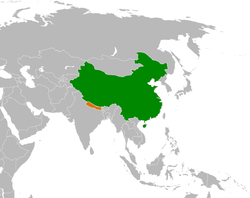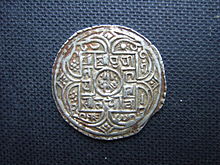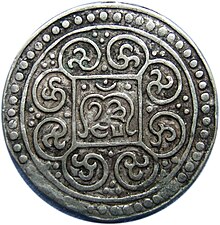 |
|
China |
Nepal |
|---|---|
The bilateral relation between Nepal and China has been friendly and is defined by the Sino-Nepal Treaty of Peace and Friendship signed on April 28, 1960 by the two countries[1]. The government of Nepal, though initially unenthusiastic about its ties with People’s Republic of China, has been of late making efforts to increase trade and connectivity with China Relations between Nepal and China got a boost when both countries solved all border disputes along China–Nepal border by signing the Sino-Nepal boundary agreement on March 21, 1960[2].
The government of both Nepal and China ratified the border agreement treaty on October 5, 1961[3]. From 1975 onward, Nepal has maintained a policy of balancing the competing influence of China and Nepal’s southern neighbour India, the only two neighbors of the Himalayan country after the annexation of the Kingdom of Sikkim by India in 1975.[4][5] Since 1975, Sino-Nepal relations have been close and grown significantly with China being the largest source of FDI,[6] while India still remains one of the major source of remittance to Nepal.[7][8] As per the estimate of Nepalese government, there are around 1-2 million Nepalese migrant workers in India while the number of Nepalis in China is minuscule (3,500 in Mainland and 15,950 in Hong Kong)[9] as of 2017.
Nepal, Tibet and China
The relationship between Nepal and Tibet are centuries old, with the Sherpa people, the Gurung people and the Thakali people of Nepal sharing close linguistic, cultural, marital, and, ethnic ties with the Tibetan people of Tibet. However, the people to people ties between these groups has been affected since 1950 onwards, after the absorption of Tibet into China resulting in the regulated border between Nepal and Tibet (as a part of China). Despite the fluctuating political scenarios in Nepal’s neighborhood and within Nepal itself, influence of Buddhism still remains strong in day-to-day life of Nepalese people living in the Himalayan Region. The Buddhist monarchy in The Kingdom of Lo (Upper Mustang), previously a part of the Tibetan Empire but now in Nepal, was terminated only in 2008.[10] The area of Lo Manthang, however, still remains quasi-restricted to foreigners.
Around 600-650 CE, Nepalese Princess Bhrikuti (Bal-mo-bza’ Khri-btsun in Tibetan) got married to Songtsän Gampo, the earliest known Emperor of Tibet.[11][12] Princess Bhrikuti, as a part of her dowry, is widely believed to have brought Buddhists relics and Thangkas to Tibet, and therefore, is attributed for establishing Buddhism as the Royal religion in Tibet. Bhrikuti is usually represented as Green Tara in Tibetan iconography. The Red Palace (Mar-po-ri Pho-drang) on Marpo Ri (Red Mountain) in Lhasa, which was later rebuilt into the thirteen storey Potala Palace by the Fifth Dalai Lama, was constructed by Newari craftsmen according to her wishes, who came to Tibet from Kathmandu with her, as a part of her dowry. She also instructed her craftsmen to construct the Tub-wang and other statues in Samye, the first Buddhist gompa in Tibet.[13] One of her craftsmen, Thro-wo, also carved the revered statue of Chenresig (Avalokiteshvara), Thungji Chen-po rang-jung nga-ldan.
During the Tang dynasty, the Chinese envoy Wang Xuance led an army of Nepalese and Tibetans to defeat an usurper in the Indian Kingdom of Magadha. In 1260 CE during the Yuan dynasty, Nepali craftsmen Araniko, on the decree of Chinese/Mongolian Emperor Kublai Khan, traveled to Shangdu and built the White Stupa of Miaoying Temple in Beijing, which was the largest structure in Beijing at that time.[14] Taking almost ten years (1279-1288 CE) to complete, the Stupa better known as White Dagoba, is still standing today and is considered to be one of the oldest Buddhist Stupa in China.
In 1789, Tibetan government stopped the usage of Nepalese coins for trade in Tibet, citing purity concerns over the copper and the silver coins minted by the Nepalese government[15][better source needed], which led to the first Nepal-Tibet war[16]. A resounding victory of Gorkha forces over Tibetans in the first Nepal-Tibet war left the Lhasa Durbar with no choice but to ask for assistance from the Qing Emperor in Peking. In the immediate aftermath of the Sino-Nepalese War (1789-1792), Nepal was forced to sign the ‘Treaty of Betrawati’[17] which stipulated that the Government of Nepal was required to make payment of tribute to Qing court in Peking once every five years, after the defeat of Gurkha forces by the Qing army in Tibet.[18]
The ‘Treaty of Betrawati’ signed by Nepal and Tibet on October 2, 1792 stipulated that both Nepal and Tibet recognize the suzerainty of the Qing Emperor Jiaqing, and further, stated that the Qing court would be obliged to help Nepal defend against any external aggression[19][better source needed]. However, during the Anglo-Nepalese War (1814–16), the Qing Emperor refused the Nepalese government’s request to provide support to Nepalese forces, and, the latter’s defeat led to the establishment of the British Empire in India.[4] Then after, Nepal initiated a policy of balancing the influence of Imperial China and British India.[4] Through the tenth quinquennial mission to China (1837), under the leadership of Chautariya Pushkar Shah, the Nepalese government again requested the Daoguang Emperor court to either send troops or a subsidy of Twenty million rupees to oppose the British. However, the Nepalese delegation was said to have been met with a stern refusal of its petition for monetary support, and opposition to the furtherance of hostility by Nepal against the British.[20] Soon after Nepal’s defeat in the Anglo-Nepalese war, from 1840 onward, Tibetan government again stopped the use Nepalese coins for trade[21][better source needed]. In an attempt to preserve the lucrative coin export business and trade advantages, the Nepalese Kingdom, under the leadership of Jung Bahadur Rana again invaded Tibet in 1855 during the second Nepalese-Tibetan War, and raided the Tashilhunpo Monastery in Shigatse, home to the Panchen Lama at that time. The invading Nepalese army was ordered to vacate the occupied Tibetan territories by the Qing Court, which was rapidly losing its hold over frontier territories due to turmoil inside China proper. Nepal’s refusal to hand back the control of Tashilhunpo Monastery led to the second Sino-Nepalese War which resulted in a stalemate; a major setback for Tibetans, ultimately culminating into the Treaty of Thapathali in March 24, 1856[22][better source needed]. Through the Treaty of Thapathali, Nepal expressed commitment to help Tibet in the event of foreign aggression while authorities in Tibet were obliged to pay the Nepalese government a sum of Nepalese Rupees 10,000 every year[4]. Further, Nepalese government stopped paying tribute to the rulers in Beijing after signing the Treaty of Thapathali. The withdrawal of Nepalese forces from Tibetan areas adjacent to Tibet-Nepal border in 1856 provided the Qing court with the opportunity to firmly tighten its grip in and around Lhasa and throughout Tibet. Soon after the Treaty of Thapathali, the Qing court also issued an edict which among other dispositions stipulated the introduction of a new silver coinage in Tibet, struck in the name of the Qianlong Emperor, the then ruler of China[23], while at the same time, Nepalese coins were completely forbidden in Tibet from then onward.[24]
During the late 19th century, after the rise of the British Raj as the unchallenged and the dominant power in the sub-continent, Nepal aligned itself with the British Raj in India and supported its invasion of Tibet in 1908.[4] When China sought to claim Tibet in 1910, Nepal sided with Tibet and Britain and broke relations with China after Tibet drove Chinese forces out in 1911.[4]
Diplomatic relations and Nepalese neutrality
The 1950 military occupation of Tibet by the People’s Liberation Army raised significant concerns of security and territorial integrity in Nepal, drawing Nepal into a close relationship with extensive economic and military ties with Republic of India.[25][26][27] China ordered restrictions on the entry of Nepalese pilgrims and contacts with Tibet. The 1950 Indo-Nepal Treaty of Peace and Friendship that had established a close Indo-Nepalese relationship on commerce, and foreign relations, was increasingly resented in Nepal, which began seeing it as an encroachment of its sovereignty and an unwelcome extension of Indian influence; the deployment of an Indian military mission in Nepal in the 1950s and unabated migration of millions of bihari Indians into Nepal’s Terai region increased these concerns.[26]
In 1955, Nepal restored diplomatic relations with the People’s Republic of China and exchanged resident ambassadors by 1960. In 1956, both nations signed a new treaty terminating the Treaty of Thapathali of 1856 and Nepal recognized Tibet as a part of China.[4] In 1960, Nepal and China signed a boundary settlement agreement and a separate ‘Sino-Nepal Treaty of Peace and Friendship’[28]. Nepal also began supporting the change of China’s seat in the United Nations.[4] In 1961, Nepal and China agreed to build an all-weather road connecting the Nepalese capital Kathmandu with Tibet. During the Sino-Indian War of 1962, Nepal maintained neutrality.[4]
Economic and strategic relations
In the late 1970s after the annexation of Kingdom of Sikkim by India, King Birendra of Nepal proposed Nepal as a “zone of peace” between India and China and in the 1980s, Nepal began importing Chinese weaponry.[4][5][25] When the United States, United Kingdom and India refused to supply arms to the regime of King Gyanendra of Nepal, who had assumed direct rule to suppress the Maoist insurgency during the Nepalese civil war (1996–2006), China responded by dispatching arms to Nepal, in spite of the ideological affinity of the Maoists with China.[29][30] After the peace process and national elections in Nepal in 2008, the new Maoist-led government announced its intentions to scrap Nepal’s 1950 treaty with India, indicating a stronger move towards closer ties with China.[29][31][32] In 2007-08, China began construction of a 770-kilometre railway connecting the Tibetan capital of Lhasa with the Nepalese border town of Khasa, connecting Nepal to China’s wider national railway network.[33]
Treaties
Nepal and China have signed a transit trade treaty and nine other pacts as of 22 of March 2016.
Points in Nepal-China Treaty 2016:
- Nepal to use China’s sea port facility
- Transit transport agreement to be reviewed every 10 years
- China to build a regional international airport in Pokhara.
- China, Nepal exploring the possibilities of signing a bilateral free trade agreement
- China to explore the possibility of finding oil and gas reserves in Nepal
- China to provide economic and technical support to Nepal to implement the project on Pokhara airport
- China to distribute solar panels in Nepal’s rural areas by tapping its Climate Fund
- China to build, manage and maintain Xiarwa Boundary River Bridge at Hilsa, Humla
- Nepal, China to strengthen intellectual property system in both the countries
- Nepal, China to extend cooperation and exchange information on banking regulations
Nepal-China Railroads
In a meeting between Chinese and Nepalese officials on 25 April 2008, the Chinese delegation announced the intention to extend the Qingzang railway to Zhangmu (Nepali: Khasa) on the Nepalese border. Nepal had requested that the railway be extended to enable trade and tourism between the two nations. On the occasion of the Nepali premier’s visit to China it was reported that construction will be completed by 2020.[18] The section Lhasa-Shigatse opened in August 2014.

From Wikipedia







